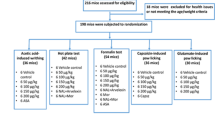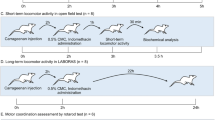Abstract
Aim:
Acetazolamide (AZA), a carbonic anhydrase (CA) inhibitor, has been found to alleviate inflammatory and neuropathic pain in rats. In the present study, we investigated the effects of AZA on thermal- and chemical-stimulated acute pain in mice and the possible mechanisms underlying the effects.
Methods:
Five acute pain models based on thermal and chemical stimuli were established to investigate the effects of AZA on different types of nociception in mice. The antinociceptive effects of methazolamide (another CA inhibitor) and diazepam (a positive allosteric modulator of GABAA receptor) were also examined. The drugs were administered either intraperitoneally (ip) or intrathecally.
Results:
AZA (50–200 mg/kg, ip) did not produce analgesia in two thermal-stimulated acute pain models, ie, mouse tail-flick and hot-plate tests. In contrast, AZA (50–200 mg/kg, ip) dose-dependently reduced paw licking time in both capsaicin and formalin tests in mice. A similar result was observed in a mouse acetic acid-induced writhing test. However, AZA (10 nmol/mouse, intrathecally) did not produce significant analgesia in the 3 chemical-stimulated acute pain models. In addition, methazolamide (50–200 mg/kg, ip) and diazepam (0.25–1.0 mg/kg, ip) did not produce significant analgesia in either thermal- or chemical-stimulated acute pain.
Conclusion:
AZA produces analgesia in chemical-stimulated, but not thermal-stimulated acute pain in mice. The attenuation of chemical-stimulated acute pain by AZA may not be due to enhancement of GABAA receptor-mediated inhibition via inhibiting CA activity but rather a peripheral ion channel-related mechanism.
Similar content being viewed by others
Log in or create a free account to read this content
Gain free access to this article, as well as selected content from this journal and more on nature.com
or
References
Moore ND . In search of an ideal analgesic for common acute pain. Acute Pain 2009; 11: 129–37.
Kaur IP, Smitha R, Aggarwal D, Kapil M . Acetazolamide: future perspective in topical glaucoma therapeutics. Int J Pharm 2002; 248: 1–14.
Velázquez H, Wright FS . Control by drugs of renal potassium handling. Annu Rev Pharmacol Toxicol 1986; 26: 293–309.
Kassamali R, Sica DA . Acetazolamide a forgotten diuretic agent. Cardiol Rev 2011; 19: 276–8.
Aaslid R . Cerebral autoregulation and vasomotor reactivity. Front Neurol Neurosci 2006; 21: 216–28.
Leaf DE, Goldfarb DS . Mechanisms of action of acetazolamide in the prophylaxis and treatment of acute mountain sickness. J Appl Physiol 2007; 102: 1313–22.
Radhakrishnan R, Sluka KA . Acetazolamide, a carbonic anhydrase inhibitor, reverses inflammation-induced thermal hyperalgesia in rats. J Pharmacol Exp Ther 2005; 313: 921–7.
Asiedu M, Ossipov MH, Kaila K, Price TJ . Acetazolamide and midazolam act synergistically to inhibit neuropathic pain. Pain 2010; 148: 302–8.
Voscopoulos C, Lema M . When does acute pain become chronic? Br J Anaesth 2010; 105: i69–i85.
Basbaum AI, Bautista DM, Scherrer G, Julius D . Cellular and molecular mechanisms of pain. Cell 2009; 139: 267–84.
Heldt SA, Ressler KJ . Amygdala-specific reduction of alpha1-GABAA receptors disrupts the anticonvulsant, locomotor, and sedative, but not anxiolytic, effects of benzodiazepines in mice. J Neurosci 2010; 30: 7139–51.
Delporte C, Backhouse N, Inostroza V, Aquirre MC, Peredo N, Silva X, et al. Analgesic activity of Ugni molinae (murtilla) in mice models of acute pain. J Ethnopharmacol 2007; 112: 162–5.
Jones CK, Peters SC, Shannon HE . Efficacy of duloxetine, a potent and balanced serotonergic and noradrenergic reuptake inhibitor, in inflammatory and acute pain models in rodents. J Pharmacol Exp Ther 2005; 312: 726–32.
Santos AR, Calixto JB . Further evidence for the involvement of tachykinin receptor subtypes in formalin and capsaicin models of pain in mice. Neuropeptides 1997; 31: 381–9.
Hylden JL, Wilcox GL . Intrathecal morphine in mice: a new technique. Eur J Pharmacol 1980; 67: 313–6.
Couto VM, Vilela FC, Dias DF, Dos Santos MH, Soncini R, Nascimento CG, et al. Antinociceptive effect of extract of Emilia sonchifolia in mice. J Ethnopharmacol 2011; 134: 348–53.
Chiba S, Nishiyama T, Yoshikawa M, Yamada Y . The antinociceptive effects of midazolam on three different types of nociception in mice. J Pharmacol Sci 2009; 109: 71–7.
Temperini C, Cecchi A, Scozzafava A, Supuran CT . Carbonic anhydrase inhibitors. Comparison of chlorthalidone, indapamide, trichloromethiazide, and furosemide X-ray crystal structures in adducts with isozyme II, when several water molecules make the difference. Bioorg Med Chem 2009; 17: 1214–21.
Yang MT, Chien WL, Lu DH, Liou HC, Fu WM . Acetazolamide impairs fear memory consolidation in rodents. Neuropharmacology 2013; 67: 412–8.
Knabl J, Witschi R, Hösl K, Reinold H, Zeilhofer UB, Ahmadi S, et al. Reversal of pathological pain through specific spinal GABA receptor subtypes. Nature 2008; 451: 330–4.
Hansen RR, Erichsen HK, Brown DT, Mirza NR, Munro G . Positive allosteric modulation of GABA-A receptors reduces capsaicin-induced primary and secondary hypersensitivity in rats. Neuropharmacology. 2012; 63: 1360–7.
Kaneko M, Hammond DL . Role of spinal gamma-aminobutyric acidA receptors in formalin-induced nociception in the rat. J Pharmacol Exp Ther 1997; 282: 928–38.
Huber VJ, Tsujita M, Yamazaki M, Sakimura K, Nakada T . Identification of arylsulfonamides as aquaporin 4 inhibitors. Bioorg Med Chem Lett 2007; 17: 1270–3.
Kim JE, Yeo SI, Ryu HJ, Kim MJ, Kim DS, Jo SM, et al. Astroglial loss and edema formation in the rat piriform cortex and hippocampus following pilocarpine-induced status epilepticus. J Comp Neurol 2010; 518: 4612–28.
Tanimura Y, Hiroaki Y, Fujiyoshi Y . Acetazolamide reversibly inhibits water conduction by aquaporin-4. J Struct Biol 2009; 166: 16–21.
Pickkers P, Hughes AD, Russel FG, Thien T, Smits P . In vivo evidence for K (Ca) channel opening properties of acetazolamide in the human vasculature. Br J Pharmacol 2001; 132: 443–50.
Nadeson R, Goodchild CS . Antinociceptive role of 5-HT1A receptors in rat spinal cord. Br J Anaesth 2002; 88: 679–84.
Acknowledgements
This work was supported by the National Natural Science Foundation of China (Grant No 81171046).
Author information
Authors and Affiliations
Corresponding authors
Rights and permissions
About this article
Cite this article
Sun, Yj., Chen, Y., Pang, C. et al. Acetazolamide attenuates chemical-stimulated but not thermal-stimulated acute pain in mice. Acta Pharmacol Sin 35, 41–47 (2014). https://doi.org/10.1038/aps.2013.149
Received:
Accepted:
Published:
Issue date:
DOI: https://doi.org/10.1038/aps.2013.149
Keywords
This article is cited by
-
Acetazolamide reduces postoperative pain following laparoscopic inguinal herniorrhaphy
Surgical Endoscopy (2016)



